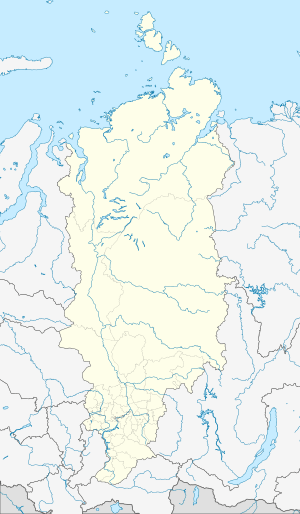Shushenskoye
| Shushenskoye (English) Шушенское (Russian) | |
|---|---|
| - Urban-type settlement - | |
|
| |
.svg.png) Location of Krasnoyarsk Krai in Russia | |
 Shushenskoye | |
|
| |
| Administrative status | |
| Country | Russia |
| Federal subject | Krasnoyarsk Krai |
| Administrative district | Shushensky District |
| Administrative center of | Shushensky District |
| Statistics | |
| Population (2010 Census) | 17,513 inhabitants[1] |
| Time zone | KRAT (UTC+07:00)[2] |
| Shushenskoye on Wikimedia Commons | |
Shushenskoye (Russian: Шу́шенское) is an urban locality (an urban-type settlement) and the administrative center of Shushensky District of Krasnoyarsk Krai, Russia, located at the confluence of the Yenisei and Big Shush. Population: 17,513 (2010 Census);[1] 19,067 (2002 Census);[3] 19,289 (1989 Census).[4]
History and culture
Vladimir Lenin was in exile here from 1897 to 1900. In 1970, a museum dedicated to Lenin's time in Siberia was opened. Presently, this museum is one of the most prominent local sights. Many visitors from all over Russia and abroad come here to see the history of Lenin's stay as well as to see the peasant way of life during the 18th century. The other feature of this area are its nature reserves.
During 2003 and 2004, a new festival was started in Shushenskoye. This festival of ethnic music is called the Sayan Ring (Саянское кольцо). Many people come here from all over Russia and abroad. Different ethno-music styles are played during its 3–4 day duration.
Climate
The climate is very warm in summer: local people cultivate melons and watermelons. Winters are very cold with temperatures as low as −40 °C (−40 °F).
References
- 1 2 Russian Federal State Statistics Service (2011). "Всероссийская перепись населения 2010 года. Том 1" [2010 All-Russian Population Census, vol. 1]. Всероссийская перепись населения 2010 года (2010 All-Russia Population Census) (in Russian). Federal State Statistics Service. Retrieved June 29, 2012.
- ↑ Правительство Российской Федерации. Федеральный закон №107-ФЗ от 3 июня 2011 г. «Об исчислении времени», в ред. Федерального закона №271-ФЗ от 03 июля 2016 г. «О внесении изменений в Федеральный закон "Об исчислении времени"». Вступил в силу по истечении шестидесяти дней после дня официального опубликования (6 августа 2011 г.). Опубликован: "Российская газета", №120, 6 июня 2011 г. (Government of the Russian Federation. Federal Law #107-FZ of June 31, 2011 On Calculating Time, as amended by the Federal Law #271-FZ of July 03, 2016 On Amending Federal Law "On Calculating Time". Effective as of after sixty days following the day of the official publication.).
- ↑ Russian Federal State Statistics Service (May 21, 2004). "Численность населения России, субъектов Российской Федерации в составе федеральных округов, районов, городских поселений, сельских населённых пунктов – районных центров и сельских населённых пунктов с населением 3 тысячи и более человек" [Population of Russia, Its Federal Districts, Federal Subjects, Districts, Urban Localities, Rural Localities—Administrative Centers, and Rural Localities with Population of Over 3,000] (XLS). Всероссийская перепись населения 2002 года [All-Russia Population Census of 2002] (in Russian). Retrieved August 9, 2014.
- ↑ Demoscope Weekly (1989). "Всесоюзная перепись населения 1989 г. Численность наличного населения союзных и автономных республик, автономных областей и округов, краёв, областей, районов, городских поселений и сёл-райцентров" [All Union Population Census of 1989: Present Population of Union and Autonomous Republics, Autonomous Oblasts and Okrugs, Krais, Oblasts, Districts, Urban Settlements, and Villages Serving as District Administrative Centers]. Всесоюзная перепись населения 1989 года [All-Union Population Census of 1989] (in Russian). Институт демографии Национального исследовательского университета: Высшая школа экономики [Institute of Demography at the National Research University: Higher School of Economics]. Retrieved August 9, 2014.